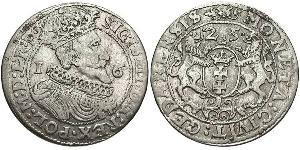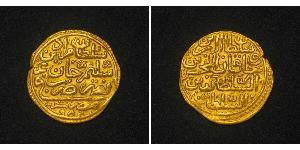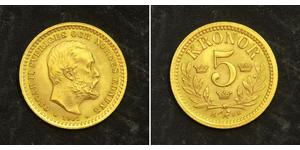(sold for $67.0)
1280, Flanders, Margaret of Constantinople. Scarce Silver Double Sterling Coin. R!
Mint Place: Gaill. 145 var.
Mint Period: 1244-1280 AD
Denomination: Double Sterling
Condition: Lightly clopped (adjusted to a later weight standard), otherwise about VF!
Diameter: 22mm
Material: Silver
Weight: 2.14gm
Obverse: Double-headed eagle within tressure.
Legend: + FLANDRIE[..] AC[..] HAYNONIE
Reverse: Long ornate cross with four letters in quadrants.
Legend: + MARGA-RETA- COMI-TISSA
The count of Flanders was the ruler or sub-ruler of the county of Flanders from the 9th century until the abolition of the position by the French revolutionaries in 1790. Although the early rulers, from Arnulf I onwards, were sometime referred to as margraves or marquesses, this alternate title largely fell out of use by the 12th century. Since then the rulers of Flanders have only been referred to as counts. The counts of Flanders enlarged their estate through a series of diplomatic manoeuvres. The counties of Hainaut, Namur, Béthune, Nevers, Auxerre, Rethel, Burgundy, and Artois were acquired via marriage with the respective heiresses. The county of Flanders itself suffered the same fate. By the marriage of Margaret III, Countess of Flanders with Philip the Bold, Duke of Burgundy, the county and the subsidiary counties were absorbed into the Duchy of Burgundy in 1405.
Authenticity uncodntionally guaranteed.
Margaret, often called Margaret of Constantinople (2 June 1202 – 10 February 1280), ruled as Countess of Flanders during 1244–1278 and Countess of Hainaut during 1244–1253 and 1257–1280. She was the younger daughter of Baldwin IX, Count of Flanders and Hainaut, and Marie of Champagne.
Called the Black (la Noire) due to her scandalous life, the children of her both marriages disputed the inheritance of her counties in the War of the Succession of Flanders and Hainault.
Her father left on the Fourth Crusade before she was born, and her mother left two years later, leaving Margaret and her older sister Joan in the guardianship of their uncle Philip of Namur.
After her mother died in 1204, and her father the next year, the now-orphaned Margaret and her sister remained under Philip of Namur's guardianship until he gave their wardship to King Philip II of France. During her time in Paris, she and her sister became familiar with the Cisterian Order, probably under influence of Blanche of Castile, the future Queen consort of France.
In 1211 Enguerrand III of Coucy offers to the King the sum of 50,000 livres to marry Joan, while his brother Thomas would marry Margaret. However, the Flemish nobility was hostile to the project, which was finally dropped.
After her sister's marriage with Infante Ferdinand of Portugal, Margaret was placed under the care of Bouchard of Avesnes, Lord of Etroen and a prominent Hainaut nobleman, who was knighted by Baldwin IX before he parted to the Crusades. In the middle of the war against France for the possession of the Artois and the forced territorial concession made by the Treaty of Pont-à-Vendin, Joan and Ferdinand wanted to marry Margaret with William II Longespée, heir of the Earldom of Salisbury, in order to reinforce the bonds of Flanders with England; however Bouchard of Avesnes, with the consent of the King of France, prevented the union.
Despite the considerable age difference between them, Bouchard gained Margaret's affection, and in presence of a significant number of bourgeois of Hainaut, she declared not want another husband than him, and before 23 July 1212 they were married.
After the capture of Ferdinand of Portugal at the Battle of Bouvines (27 July 1214), Bouchard of Avesnes claimed to Joan in the name of his wife her share of their inheritance, which led Joan to attempt to get Margaret's marriage dissolved; in addition, the French King began to see Bouchard with suspicion because he fought in the Flemish army.
Philip II informed Pope Innocent III that before his wedding, Bouchard of Avesnes have already received holy orders as sub-deacon, so technically his union was illegal. In 1215, at the Fourth Council of the Lateran, the Pope annulled the marriage on this ground; however, Margaret and Bouchard refused to submit and they took refuge at the Castle of Houffalize in the Ardennes under the protection of Waleran, Count of Luxembourg. In the following four years, they had three sons:
- Baldwin of Avesnes (1217 – 1219), who died in infancy.
- John of Avesnes (1 May 1218 – 24 December 1257).
- Baldwin of Avesnes (September 1219 – 10 April 1295).
In 1219, in a battle against Joan, Bouchard of Avesnes was captured and imprisoned for two years, until 1221, when he was released on the condition that he separate from his wife and made a trip to Rome to get the absolution from the Pope. While he was in Rome in order to obtain not only the forgiveness but also the release of the holy orders to made his union legitimate, Joan took advantage of this to convinced Margaret (who after Bouchard's capture came to live at her court, leaving her two sons in France under custody) to contracted a new wedding. Finally Margaret gave in to her sister's pressures, and between 18 August and 15 November 1223, she married with William II of Dampierre, Lord of Dampierre, a nobleman from Champagne. They had five children:
- William III of Dampierre (1224 – 6 June 1251).
- Joan of Dampierre (c. 1225 – 1245/1246), married in 1239 to Hugh III of Rethel, then in 1243 to Theobald II of Bar.
- Guy of Dampierre (c. 1226 – 7 March 1305).
- John of Dampierre (c. 1228 – 1258), Lord of Dampierre-sur-l'Aube, Sompuis and Saint-Dizier, Viscount of Troyes and Constable of Champagne.
- Marie of Dampierre (c. 1230 – 21 December 1302), Abbess of Flines, near Douai.
This situation caused something of a scandal, for the marriage was possibly bigamous, and violated the church's strictures on consanguinity as well. The disputes regarding the validity of the two marriages and the legitimacy of Margaret's children by each husband continued for decades, becoming entangled in the politics of the Holy Roman Empire and resulting in the long War of the Succession of Flanders and Hainault.
At the death of her sister Joan in 1244, Margaret succeeded her as Countess of Flanders and Hainaut. Almost immediately, her sons from both marriages began the fight for the inheritance of the Counties, with the question of the validity of her first marriage to Bouchard of Avesnes was then raised, as if it was indeed illegitimate the inheritance of Flanders and Hainaut was passed only to the children from her second marriage, already favored by Margaret in 1245 when she paid homage to King Louis IX of France: at that point, she tried to obtain from the French King the recognition of William of Dampierre, the eldest son of her second marriage, as sole heir, arguing that Pope Gregory IX declared her first marriage invalid on 31 March 1237 and thus her sons from this union were illegitimate.
In 1246 Louis IX, acting as an arbitrator, gave the right to inherit Flanders to the Dampierre children, and the rights to Hainaut to the Avesnes children. This would seem to have settled the matter, but neither party accepted the solomonic decision of the French King, while responding to the spirit of fairness of the monarch, it had a political effect clearly advantageous for the interests of France, to dislocate the county, and served to avoid war. However, in 1248 Juan of Avesnes took advantage of the departure of Louis IX to the Crusades accompanied by William of Dampierre, to started the war against his mother, taking Hainaut and Alost with other surrounding Flemish territories.
Margaret, thinking that the inheritance disputes were finally over after her son William of Dampierre paid homage for Flanders as her co-ruler to both Louis IX (in October 1246) and Emperor Frederick II (in 1248), made the political mistake to obtain from the Pope in 1251 the legitimation of both John and Baldwin of Avesnes, giving them rights of birth over the Counties.
The unexpected death of William of Dampierre (6 June 1251) –who reportedly died from injuries received during a tournament, although his mother suspected that the allies of Avesnes were responsible– caused the renewal of the hostilities when John of Avesnes, who was uneasy about his rights, convinced William II of Holland, the German King recognized by the pro-papal forces, to seize Hainaut and the parts of Flanders which were within the bounds of the Holy Roman Empire. William II was theoretically, as King, overlord for these territories, and also John's brother-in-law. A civil war followed, which ended when the Avesnes forces defeated and imprisoned Guy of Dampierre (who had succeeded his brother as co-ruler of Flanders) at Westkappel, on the island of Walcheren, in July 1253.
Margaret offered the County of Hainaut to Charles of Anjou (brother of Louis IX) in order to obtain his military intervention against William II. Charles besieged Valenciennes, but a truce was negotiated between all parties on 26 July 1254, which included an agreement to submit the dispute to Louis IX for adjudication. Guy of Dampierre was ransomed in 1256 and Louis IX confirmed his 1246 decision regarding the Hainaut-Flanders split between the Avesnes and Dampierre children, while Charles of Anjou renounced to all his claims over Hainaut. The death of John of Avesnes in 1257 put a temporary halt over the already costly internecine quarrel.
Matthew Paris, who in his writings showed a complete dislike to Margaret, calling her "...a new Medea guilty of the death of many honest knights", related that after the capture of Guy and John of Dampierre at Westkappel, John of Avesnes tried to use them as hostages to force his mother to negotiate peace; however, the alleged response of the Countess was shockingly categorical:
Sacrifice them, you truculent meat eater and devours one of them cooked with pepper sauce and other roasted with garlic.
Because the Avesnes heir, her grandson John II was still underage, Margaret managed to recovered the government of Hainaut, while in Flanders she kept her son Guy of Dampierre as her co-ruler until 29 December 1278, when she abdicated in his favor, retaining Hainaut as sole ruler until May 1279, when she appointed John II as her co-ruler in Hainaut until her death nine months later, in February 1280. John II of Avesnes then succeeded her as sole Count of Hainaut, and through his marriage, he became Count of Holland and Zeeland in 1299.
Margaret's death ended the personal union between Flanders and Hainaut, who lasted for almost one century. Both Counties were only reunited again in 1432 when Jacqueline of Bavaria, the Avesnes heiress, surrender her domains to Philip III, Duke of Burgundy, the Dampierre heir.
Like her sister, Margaret conducted an economic policy designed to encourage international commerce. She removed restrictions on foreigner traders, despite pressures from local traders, who wanted to maintain monopolies. She also issued a new coinage. The huge debts that she contracted due to the War of Succession, however, forced Margaret to made concessions to the main Flemish cities, who gained political independence.
Her policies also helped to turn Bruges into an international port, granting privileges to the merchants of Poitou, Gascony and Castile, in addition to improvements in the water gates. During 1270-1275 she became involved in a trade war with England, probably the first time that the economy was openly used as a weapon in a conflict between states with unfavorable outcome. Margaret demanded from England payments for her support during the revolt of Simon de Montfort. Because King Henry III claimed that because he recruit mercenary soldiers, he didn't see any reason to made payments.
In retaliation, Margaret seized the possessions of English merchants in Flanders while Henry III and later her son and successor Edward I seized those of Flemish merchants in England and also stopped the exports of wool to Flanders and townspeole who depended on the textile trade pressured the Countess and her son Guy to entered in negotiations with the English; henceforth the Flemish no longer dominated the transport of goods between the continent and England.
Like her sister, Margaret supported and founded religious houses. In 1245, she founded the Béguinage in Bruges. She also had an interest in architecture and patronized writers and poets. In 1260 she founded the Abbey of Saint Elizabeth du Quesnoy, now destroyed.
Closely related to the Dominican Order during her stay in Valenciennes after her marital separation, Margaret founded convents of this order in Ypres and Douai. She is thought to be the Dutchess who sought advice from Thomas Aquinas in matters of government, by asking moral questions about usury and the treatment of Jews who practiced, and on the sale of offices, if she was the recipient of the Letter to the Duchess of Brabant as was thought.
Only 1$ shipping for each additional coin purchased!

|
Posted by:
anonymous 2016-10-23 |
5 Krone Sweden Gold Oscar II of Sweden (1829-1907)
group has 9 coins / 8 prices
⇑























